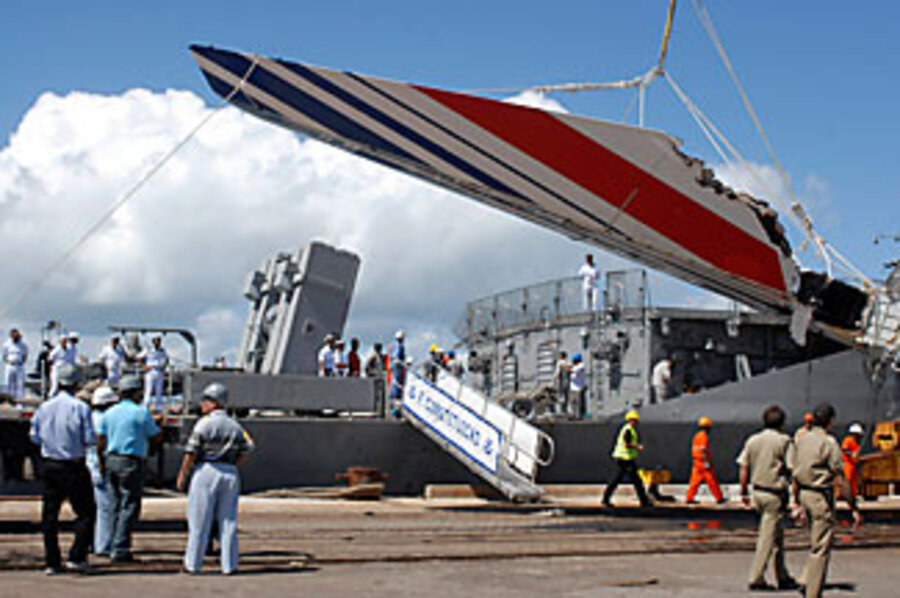Air France crash: What is known so far
Loading...
In the two weeks since Air France Flight 447 disappeared above the south Atlantic, clues have offered no clear answers as to why the plane crashed.
Perhaps only the planes' black boxes, likely now beneath two miles of water, will ever be able to explain why the aircraft fired off 24 warning messages in the four minutes before it disappeared – and whether these messages point to the cause of the crash or are merely one piece of some larger problem.
A French nuclear submarine and a Dutch ship towing a US Navy listening device searched the area Sunday, seeking the telltale ping of the black box.
Here are what appear to be some of the key clues:
The crash. The evidence gathered so far, while not conclusive, suggests that the plane broke up at high altitudes. Two sets of bodies were found dozens of miles apart. It is not impossible that currents could account for the separation, but a high-altitude breakup is considered more likely.
Moreover, investigators say the bodies were dead before they hit the water. There was no water in the lungs of the dead – something that would suggest drowning.
The plane itself also offers potentially telltale clues: The last of the airplane computer's messages reported that cabin pressure, usually maintained at an equivalent to an elevation of 10,000 feet, was dropping at a rate of 1,800 feet per minute.
Cabin pressure had been lost and one obvious cause could be that the plane was falling apart.
The cause. What is known is that the airplane's flight path took it through an area of severe weather. What is also known is that the series of failures reported by the computer would have been difficult for pilots to handle even under ideal flying conditions. Strong turbulence would have made the job far more daunting.
Questions have centered around the plane's flight speed and the Pitot tubes designed to measure it. One of the plane's warning messages suggests that the computer was receiving conflicting data about how fast it was flying. Keeping an aircraft within an acceptable range of speed is crucial – and very difficult without speed data or autopilot in a storm. Too fast, and a pilot risks stressing the plane to the breaking point. Too slow and the plane loses lift.
That message was accompanied by a burst of others between 2:10 and 2:14 a.m. Greenwich Mean Time:
- The autopilot was turned off, though it is not clear if this was done by pilots or the computer.
- Gyroscopes needed to keep the plane flying level failed.
- The computers entered the plane into "alternate flight law" a sort of "safe mode" intended to prevent the pilots from making any drastic mistakes.
- The rudder limiter reported problems. The rudder limiter prevents pilots from turning the tail rudder too wildly at high speeds – an act that could shear the entire rear stabilizer off the plane.
This, in particular, is a curious clue, because the rear stabilizer has been found torn from the plane – the very thing the computer was trying to prevent.
- The primary, secondary, and flight-management computers failed.
The Times of London reports that a similar "incoherent cocktail of alarms" occurred six times on Air France flights since February 2008. Though pilots eventually regained control in those instances, one situation became so dire that the pilot issued a mayday call. In each case, the emergency appeared to be linked to Pitot tubes that malfunctioned in stormy weather, The Times concludes.
Airbus had suggested replacing Pitot tubes on its A330 aircraft. Air France had begun the work, but had not replaced the tubes on Flight 447.
The French Bureau of Investigations and Analyses, however, has refused to blame the Pitot sensors. Experts, too, caution against inferring a certain line of cause and effect while so much crucial information is still unknown.
What appears clear, though, is that the trouble mounted quickly. Flight 447's pilots made no mayday or emergency transmission, and photos of the crew's seats show them folded, meaning the crew had not yet returned to them in response to an emergency.
Also increasingly apparent is that the flight was not downed by a bomb. The bodies recovered so far have had no burns or shrapnel.
The recovery. As of Sunday, 49 bodies had been recovered. The search for the black boxes was mounting. But the challenge is enormous. After a 2004 plane crash off the coast of Egypt, authorities needed two weeks to recover the black boxes, even though the crash was relatively close to shore.
"This time, the sea floor is more than 4,000 meters [13,000 feet] deep in some areas, and the ocean bed is described as extremely varied in depth," notes Aviation Week.





